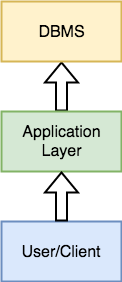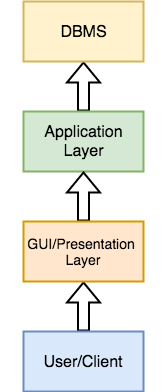Understanding DBMS Architecture
A Database Management system is not always directly available for
users and applications to access and store data in it. A Database
Management system can be centralised(all the data stored at one location), decentralised(multiple copies of database at different locations) or hierarchical, depending upon its architecture.
1-tier DBMS architecture also exist, this is when the database
is directly available to the user for using it to store data. Generally
such a setup is used for local application development, where
programmers communicate directly with the database for quick response.
Database Architecture is logically of two types:
- 2-tier DBMS architecture
- 3-tier DBMS architecture
- 2-tier DBMS Architecture
- 2-tier DBMS architecture includes an Application layer between the user and the DBMS, which is responsible to communicate the user's request to the database management system and then send the response from the DBMS to the user. An application interface known as ODBC(Open Database Connectivity) provides an API that allow client side program to call the DBMS. Most DBMS vendors provide ODBC drivers for their DBMS.
 Such an architecture provides the DBMS extra security as it is not exposed to the End User directly. Also, security can be improved by adding security and authentication checks in the Application layer too.
Such an architecture provides the DBMS extra security as it is not exposed to the End User directly. Also, security can be improved by adding security and authentication checks in the Application layer too.3-tier DBMS Architecture
3-tier DBMS architecture is the most commonly used architecture for web applications.
 It is an extension of the 2-tier architecture. In the 2-tier architecture, we have an application layer which can be accessed programatically to perform various operations on the DBMS. The application generally understands the Database Access Language and processes end users requests to the DBMS.In 3-tier architecture, an additional Presentation or GUI Layer is added, which provides a graphical user interface for the End user to interact with the DBMS.For the end user, the GUI layer is the Database System, and the end user has no idea about the application layer and the DBMS system.If you have used MySQL, then you must have seen PHPMyAdmin, it is the best example of a 3-tier DBMS architecture.
It is an extension of the 2-tier architecture. In the 2-tier architecture, we have an application layer which can be accessed programatically to perform various operations on the DBMS. The application generally understands the Database Access Language and processes end users requests to the DBMS.In 3-tier architecture, an additional Presentation or GUI Layer is added, which provides a graphical user interface for the End user to interact with the DBMS.For the end user, the GUI layer is the Database System, and the end user has no idea about the application layer and the DBMS system.If you have used MySQL, then you must have seen PHPMyAdmin, it is the best example of a 3-tier DBMS architecture.
Comments
Post a Comment